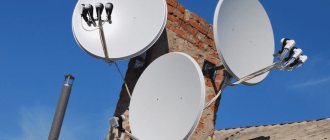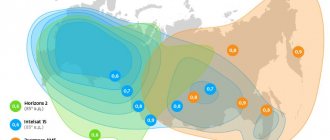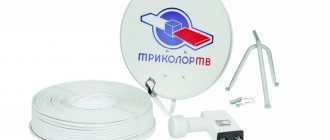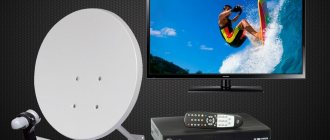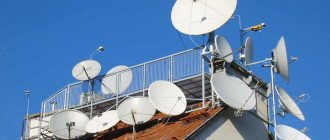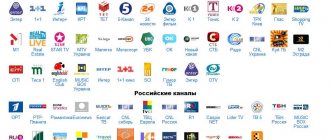- home
- Events and Reviews
Probably everyone has heard about satellite television reception. However, not everyone fully understands what its advantages and disadvantages are compared to broadcast and cable broadcasting. This article does not pretend to be complete and cover all possible nuances of satellite reception. Presented in an easy-to-understand form, the general information will be useful for novice users who would like to know how much satellite television they need and what is required to use it.
First, let's define the main types of broadcasting so that there is no further confusion:
- On-air broadcasting. To implement this, television towers are placed in cities. It is from them that the channels are broadcast. Users who wish to receive this type of broadcast must have their own television antenna or use a shared one, if available. A collective television antenna is often found in apartment buildings.
- Cable broadcasting. It is carried out by cable operators. In order to use their services, your home must be connected to such operators. Often several companies work in one multi-storey building, so you can choose which one you like best. Regardless of the chosen operator, a cable is installed into the apartment, through which, in fact, you will receive channels.
- Satellite broadcasting. In this case, the channels are broadcast from satellites, which are distributed above the Earth’s equator at an altitude of about 36 thousand km. The peculiarity of these satellites is that for an observer from Earth their position in the sky remains constant. This is achieved by the strict location of the satellites in the plane of the Earth's equator, as well as their constant angular velocity, coinciding with the angular velocity of the Earth's rotation. It is possible to receive signals from satellites only with the help of special antennas aimed at them, made in the form of dishes.
Broadcasting and cable broadcasting can be analogue or digital. The latter type of broadcasting began to spread relatively recently and therefore most televisions and many computer TV tuners were not suitable for receiving it. To be able to work with a digital signal, the TV tuner or TV model must be digital or hybrid (digital and analog at the same time). If the TV is not one, or does not support the required digital broadcast format, a receiver can come to the rescue. These are small set-top boxes that resemble household DVD players in appearance. They convert the received digital signal into a format understandable to other technology.
Satellite broadcasting was also analogue at first, but has now been completely replaced by digital. Therefore, in this case, you don’t have to bother yourself with the types of satellite receivers that once existed, but simply take note that all modern devices for individual reception of satellite television are digital. There are also receivers for the operation of regular TVs and various types of displays/panels with satellite signals.
A very important point is that digital broadcast formats differ for broadcast, cable and satellite. Therefore, for example, if you have a receiver for receiving digital cable channels, you will not be able to receive terrestrial or satellite digital channels with it. In each case, a different standard is used. Moreover, in Europe we have adopted some standards for each type of broadcasting, while, for example, in the USA and Japan - others.
European digital broadcasting standards:
- DVB-T is terrestrial, which is also called “terrestrial” broadcasting.
- DVB-C is cable broadcasting used in cable networks.
- DVB-S and DVB-S2 are satellite broadcasting standards. The latter is more modern and promising.
There is also a digital broadcast standard DVB-H , intended for mobile phones. Mobile operators are already beginning to broadcast TV channels using it in some cities. However, within the framework of this article it is not of particular interest, and was named only for completeness of information.
Compared to analogue, the main advantages of digital broadcasting are obvious - the ability to provide higher quality image and sound, as well as a significantly increased number of channels that can be broadcast over the air, via cable network or from satellites. Additional advantages of digital broadcasting include the potential for implementing useful services, for example, broadcasting a TV program, subtitles, multi-channel audio, several audio tracks in different languages, etc. Among other things, digital broadcasting makes it easy to solve the problem of distributing paid content.
Watching paid digital channels usually involves the use of access cards, which must be periodically purchased or topped up with money. These cards are inserted into specially designated slots located on television sets or receivers. Unfortunately, such connectors are not particularly common on televisions and computer TV tuners, and therefore, to watch premium channels, you often have to use receivers. By the way, please note that receivers also come without slots for access cards, i.e. intended only for viewing free channels.
The choice of broadcast type depends on the following key factors:
- Subscription fee amount. By selecting the type of broadcasting, as well as different operating companies providing broadcasting, you can select an acceptable subscription fee. Currently, this applies to satellite and cable operators, but with the transition of broadcasting from analog to digital, it will be relevant for them as well. In the future, only a small part of the channels on the air will remain free (free to receive), others will be offered for money. Moreover, offers of different subscription fees will be available, differing in the subject of channels and their number. This practice is already widespread among satellite operators and is gradually being introduced among cable operators.
- Equipment costs. To receive terrestrial, cable or satellite television, equipment specific to each type of broadcast is required. Its cost may vary significantly depending on the supported standards, the availability of additional functions and manufacturers. Terrestrial and cable analogue broadcasting may seem the cheapest to receive, but this is only because many users already have analogue TVs and analogue computer TV tuners. In fact, the difference in cost, for example, between analog TV tuner models and models that additionally support digital broadcasting is very small. Comparing the cost of directly receiving antennas, in particular for terrestrial and satellite television, the latter, of course, will be more expensive. However, the difference may not be very significant.
- Conditions of admission. This is one of the most important factors that should be taken into account when choosing the type of broadcast, because, as you know, everyone’s reception conditions are different. Someone lives in the city, and their apartment windows look directly onto a television tower, so it is easiest to receive over-the-air channels. Someone else may also live in the city, but in a low-rise building located among other tall buildings, for which reason even a collective antenna on the roof is not able to provide high-quality reception of over-the-air channels. In this case, if there are cable operators in the house, it is easier to contact them. If there are none, then the best solution would be satellite reception. Another example is if TV channels need to be received outside the city. If you are a short distance from the city and there are no visible obstacles to reception, you can try to use over-the-air broadcasting, however, the best choice will most likely be satellite reception.
- Your interests. Obviously, for some, several public television channels may be enough, while others may want television channels on a specific topic or simply as many of them as possible. Fortunately, the choice is now great. Cable operators compete to see who can offer the most channels at the lowest cost. The channel sets of different cable operators are also different. Among satellite television operators, competition is no less fierce and the range of paid packages offered, differing in subject matter and number of channels, is even wider.
- Technologies used. In this case, we are talking not only about digital and analogue broadcasting formats, which, of course, is important. The difference between operators, mainly cable and satellite, may lie in other equally important points. For analogue broadcasting, this means that channels have stereo sound in A2/NICAM standards. Some cable operators consider this overkill, although most modern televisions and computer TV tuners have appropriate decoders. For digital broadcasting there are more differences. Firstly, there are high definition channels (HDTV), which look much better on a big screen. Secondly, this is the format and bitrate of channel broadcasting, which directly affects the quality. Bitrate is the bit rate, which for standard definition channels broadcast in MPEG-2 format should preferably be at least 4-5 Mbit/sec. The MPEG-4 format is more promising. With a similar bitrate, it is able to provide better quality than MPEG-2.
A number of users have the preconception that satellite television is necessarily better than any other type of broadcasting. However, this is not at all true. If you look at it, most of the advantages that are often cited as key for satellite broadcasting are quite applicable for cable broadcasting, as well as for terrestrial broadcasting.
For example, you often hear that satellite broadcasting is of higher quality. To confirm or refute this statement, it is necessary to find out what the comparison is being made with and which satellite channels. Comparing, in particular, satellite broadcasting with digital terrestrial or digital cable, it may turn out that the latter will be of higher quality. In any case, there are no barriers to this. Any digital broadcast can have high bitrate channels and high definition video. Some cities in Russia have already begun broadcasting HDTV channels on air and cable networks, so satellite broadcasting in this case is not at all the leader.
You need to understand that there are different channels and they can be broadcast in different ways. It makes no difference exactly how the broadcast is carried out - on air, via cable network or from satellite. When considering paid satellite channels, the chances that they will be of good quality are higher than those of free ones. After all, broadcasters should be interested in providing quality services.
Reception of satellite channels
To receive satellite channels, at a minimum, you will need a satellite antenna in the form of a dish and a satellite receiver, connected to each other by an antenna cable. The receiver can be a computer TV tuner or a receiver connected to a regular TV or other display. Since we are in Europe, the TV tuner or receiver must support the European DVB-S satellite broadcasting standard. DVB-S2 support is desirable, but not mandatory yet.
Thus, as you can see, the set of minimum necessary satellite equipment for receiving TV channels is not at all large. And a satellite dish and, for example, a satellite computer TV tuner are not expensive. Depending on the type and manufacturing companies, it is quite possible to meet the total amount of 100-120 dollars.
As an option, you can use ready-made sets of satellite equipment offered by broadcasting companies. In particular, many have probably already heard about the existence of Tricolor TV, NTV Plus, Orion Express, Platform HD and others. All of them include a satellite dish of the required size, a receiver of the required type, a cable and an access card, if viewing channels is offered on a paid basis. Such kits are somewhat more expensive than if the same equipment is purchased separately. However, if you need to receive channels from a specific broadcaster, and you do not understand the existing equipment for satellite reception, then it is probably not worth saving. It is better to give preference to a ready-made solution.
Some difficulties and simply fear for many users are caused by the need to install and configure a satellite dish. This may be due to several reasons. Firstly, the antenna must be mounted outdoors, which is not always easy or convenient. Secondly, there is no general step-by-step guide for installing and configuring a satellite dish, since in each case you have to adapt to your own reception conditions and the satellite you need. Thirdly, it is advisable to have experience and a general understanding of how it works in order to direct the antenna exactly to the desired position.
Before purchasing satellite equipment, you should decide on the satellite whose television channels you would like to receive, as well as the place where you can mount the antenna. It’s easier with ready-made satellite kits - they are designed and optimized to receive signals from predetermined satellites. If you select satellite equipment yourself, keep in mind that the required antenna dimensions, the type of converter installed on the antenna, and the type of receiver or computer TV tuner depend on the selected satellite. In addition, some satellites are located to the east above the Earth’s equator, some to the west, and this determines the sector of the sky that should be accessible to the antenna.
The choice of broadcast type depends on the following key factors
- Antenna size. A small antenna up to 0.9 meters, when installed in a multi-story building, can be placed on a wall near a window or on a balcony. It is recommended to place a large antenna in such a house on its roof.
- Your location. As already mentioned, satellites are located above the Earth's equator. Therefore, if you are in the northern hemisphere, then the antenna will have to be pointed in a southerly direction, the exact degree of which will depend on the selected satellite. Accordingly, if your windows and the wall where you thought to mount the satellite dish look in the north direction, then nothing will work, you will have to look for another place.
- No obstacles. The antenna's visibility to satellites must be direct. It is unacceptable for something to block it. If you live on the first floors of a multi-storey building, then make sure that there are no tall trees in front of your windows or the proximity of any high-rise buildings. They can interfere with the signal or make it completely unavailable.
An experienced satellite dish installer can immediately assess the suitability of a particular location for installing an antenna. If you would like to install an antenna near a window, but do not have experience or doubt the location is suitable, it is still better to ask for help. Installing a satellite dish on the roof of a house is almost always possible. Moreover, it is easier and safer to install it on the roof, the main thing is to gain access there. In apartment buildings, attics are usually locked and keys are not given to just anyone to get into them.
By and large, you should not be afraid of installing a satellite dish. If you are a radio amateur or a technically literate person, and also have the free time that is usually required to get acquainted with the theory of satellite reception, then you can install the antenna yourself. Everyone else who doubts their abilities or does not have free time can order installation. Fortunately, this service has now become widespread and is not expensive. In addition, it is often offered along with ready-made satellite kits.
Reception of multiple satellites
Before this, we talked about receiving TV channels only from individual satellites, since it is the easiest and cheapest. It is obvious that the kits for satellite reception offered on the market from broadcasting companies are also focused on certain satellites from which these companies broadcast TV channels. However, sometimes it may be necessary to receive several satellites at once, and this is what will be discussed below.
The simplest and most obvious way to receive several satellites at once is to install several satellite antennas, each of which must have a setting appropriate for its satellite. In some cases, satellite equipment installers do just that. However, despite the acceptability of this approach, and in some cases even its optimality, there are other methods that can often turn out to be more correct and universal.
Among these is the installation of two or more converters with some offset on one satellite dish. This is done if it is necessary to receive several satellites that are located at a short distance from each other. For 2-4 satellites, even a regular satellite dish with a traditional shape is suitable. To receive a larger number of satellites using this method, you may need an antenna that is somewhat elongated and curved horizontally, the cost of which, due to its uniqueness, is obviously higher.
The method of installing several converters on an antenna is called “multifed” from the English word multifeed - multipoint. In fact, when this word is used by users with experience in receiving satellite broadcasts, they mean the simplest device that allows you to install additional converters on a satellite dish. In this case, the main converter, as usual, is placed in the center, and additional ones, at the required distance and at the desired angle, next to it.
Another way to receive multiple satellites is to rotate the satellite dish. To constantly move it to different positions, a special device called a “motor suspension” or simply a “motor” can be used. Usually it is a small metal box, from one side of which comes a curved massive tube and connectors. The motor suspension (box) is mounted on the support of the satellite dish, and the antenna itself is attached to its tube. The slow rotation of the motor suspension tube around its axis, as well as its curvature, make it possible to rotate the satellite antenna along a special parabolic trajectory, which, in fact, is required to be ensured.
Under favorable reception conditions, the motopods allow you to tune in to 15-20 satellites. Currently, these devices are quite common and are relatively inexpensive. Therefore, if you need to assemble universal satellite equipment for reasonable money, this is your choice. However, note that some satellites require a large antenna, so if you want to capture them too, you will have to forget about the small antenna. Motorized suspensions usually allow you to rotate satellite dishes up to 1.2 meters in size. This is the best one to use. In extreme cases, 0.9 meters is possible, but not all satellites will be caught, although most of them will be.
Another feature that you have to deal with when receiving several satellites is that they can broadcast a signal with different polarization. There are universal converters that support signals with horizontal and vertical polarization. There are also converters for working with circular polarization. For this reason, to ensure greater versatility, two converters can be installed on an antenna with a motorized suspension.
In the case of receiving several satellites using a multifeed or several antennas, it is obvious that each of them is assigned a separate converter. Therefore, choosing the right type for each satellite at once will not be difficult. By the way, unlike a motorized suspension, which needs to be constantly adjusted, the use of a multi-feed or several antennas allows you to receive a signal from several satellites at the same time. True, to take advantage of this advantage, you must also have several satellite receivers.
For the convenience of working with universal satellite equipment, there is a special communication protocol - DiSEqC, which is supported by many modern devices. These include converters, switches, motor suspensions and the receiving part - satellite receivers and computer TV tuners. This protocol is good because it allows you to fully automate the process of switching and regular reconfiguration of satellite equipment. At the same time, it does not require connecting devices with additional wires. The equipment is controlled through existing antenna cables.
With the use of satellite equipment that supports the DiSEqC protocol, it does not matter how many converters you have and how many antennas they are located on. All converters, via a DiSEqC switch, can be simultaneously connected to one input of the satellite receiver. The choice of which converter should be used will be made programmatically through the receiver's on-screen menu or computer TV tuner software. TV channels scanned from each converter can be presented in a general list. Thus, simply flipping through the channels during further work, the connection of the converters needed for them will be carried out automatically.
Working with a satellite dish mounted on a motorcycle suspension becomes just as easy. Thanks to the DiSEqC protocol, the position of the motorized suspension can be adjusted from the receiver menu or from the software of a computer TV tuner. For each such position, corresponding to an individual satellite, a channel scan is launched, after which all found channels can also be presented in a general list. Well, then, by simply flipping through these channels, the motor suspension will make turns to the desired positions automatically.
conclusions
The range of satellite television channels offered today is very large. In total, in the central part of Russia, up to several thousand of them can be received. However, all this diversity will most likely please only enthusiasts. Ordinary users can hardly be advised to install universal satellite equipment. The reasons for this are simple - only a small part of the numerous free channels from the total mass will be in Russian and with good quality, and receiving paid channels from several satellite operators is expensive and does not make much sense. It is better to choose one broadcaster that suits you best.
If you live in or near the city, take the time to explore all the offers. Reception of satellite television may not have any obvious advantages compared to cable and terrestrial broadcasting, especially if we consider the digital varieties that are now being introduced in many cities. The choice of broadcasting type should be determined based on the available reception conditions, offers from operator companies in your region, your own interests and other factors discussed in the article.
Packages and tariff plans
Having decided which operator is best suited for the region of installation, you need to select a favorable tariff package.
The largest satellite television operator, which is today preferred by more than 12 million Russian families, the Tricolor company, offers basic and additional tariffs. Basic:
- “Unified”, providing reception of 224 TV channels for 1500 rubles/year.
- “Unified Multi” - 215 television channels for 2000 rubles/year.
- “Unified UHD” transmits 231 TV channels for 2,500 rubles/year.
- “Extra” - 225 channels for 2000 rubles/year.
Important: The Ultra HD tariff plan can only be used if you purchase a UHD receiver, as well as if you have an ultra-high definition image transmission function on your TV.
Additional packages include:
- Ultra HD - 7 channels;
- "Children's", broadcasting 22 TV channels;
- “Nochnoy”, broadcasting 7 TV channels for adult audiences;
- "MATCH! Premier" with two sports channels;
- "MATCH! Football" - 6 TV channels.
Another popular satellite television provider among Russian residents,
Telekarta company has the following tariffs in its line of offers:
- "Master". For a payment of 149 rubles. 140 channels are available to the user per month.
- “Leader” - 220 TV channels for a monthly fee of 249 rubles. per month.
- "Premier" for 399 rub. per month the user gets access to 240 TV channels.
- "Pioneer". The most economical tariff, including 95 channels for 67 rubles. per month.
What is better to connect?
The connection option depends largely on the location of the facility and the presence of mobile operators in the area, as well as the availability of equipment to strengthen the signal. Making any connection where there are no obstacles is not a difficult task. But somewhere in the outback, connecting via a fiber optic cable or the Internet is unlikely to be possible.
In places where all connectivity options are available, everything has changed with the advent of interactive television. By turning on the TV, you can watch movies and videos on YouTube online, download any applications and games from Google Play, visit Internet sites, and listen to music. The choice of television channels is huge, and you do not need to connect to cable television.
“The trend now is that everyone is switching to IP telephony and Internet television. In most cases, when connecting and installing, they abandon the antenna because there are few channels and the quality is not the same. Television manufacturers are now moving towards HD picture quality and 5K resolution displays. Accordingly, to watch full HD, a regular antenna with a regular signal is no longer suitable. Everything is going towards Internet technologies. There are special set-top boxes that transmit everything via the Internet,” says expert in the field of telecommunications technologies Evgeniy Abramov .
Which one is better to choose?
Most often, an offset-type parabolic antenna is installed in ordinary apartments and private houses. The first thing you should pay attention to when choosing a device is its diameter. The standard dish size is 55–65 cm; in remote regions with poor signal levels the figure is 80 cm or more.
Experts call Supral 0.9 one of the most current TV antennas aimed at enhanced reception. Satellite operators call this device one of the most reliable. Due to its diameter, the antenna is quite heavy. This simultaneously makes it more difficult to install, but also makes it more reliable and weather-resistant. Such a plate can withstand any gust of wind.
Lans 65 is a perforated satellite dish with a diameter of 65 cm. This is a budget option, but according to expert comments, one of the most functional. It provides high signal quality, does not require additional cleaning - due to the holes in the surface, snow and debris do not collect on it, and has an interesting design and ease of installation.
Satellite television
Satellite television is also a type of digital broadcasting. However, it has an excellent operating principle. The signal in this case is distributed from satellites in space. They are located in such a way as to provide high-quality coverage to a certain territory, for example, Russia. The advantage of satellite broadcasting is a larger number of channels, independence from weather conditions and user location . And the last point is the most important when choosing, since all other types are not available to the entire population of the country.
The disadvantage of digital satellite television is the need to purchase complex and expensive equipment. In addition to the receiver or conditional access module, you need a satellite dish that receives the signal. It has complex installation and certain installation conditions. Therefore, connecting satellite TV to an apartment is more difficult than any other option, and usually specialists are called in for this purpose, which entails financial costs. Satellite TV is the most expensive type of digital television. You need to spend money on equipment, installation, and then pay for subscriptions.
Rating of the best satellite TV sets
Based on expert reviews and reviews from equipment sellers, it is possible to determine the rating of satellite operators today.
The top kits are compiled taking into account several parameters:
- Menu availability.
- Difficulty setting up.
- Number of connected television receivers.
- The receiver has a USB input for connecting an external storage device or hard drive.
- Possibility of creating favorite lists.
- Broadcast standards.
- Available picture formats.
- Availability and length of coaxial cable.
- Design.
- TV antenna diameter.
Tricolor Full HD DTS 53L
The Tricolor Full HD DTS 53L set is called the leader among urban and suburban residents. It is especially appreciated by sports fans for free access to football channels.
The kit includes:
- plate with a diameter of 55 cm;
- wall bracket;
- converter;
- cable;
- digital set-top box;
- subscriber instructions;
- operator access card.
Supported TV broadcast format DVB S/DVB S2.
Among the advantages of the set:
- supports multiple channels;
- produces good picture quality;
- 30 radio stations available;
- easy to set up;
- the operator provides a free one-week trial period.
Disadvantages of interactive TV
Speaking about the pros and cons of television, it should be noted that there are obvious disadvantages.
- To broadcast channels, a special STB set-top box is required. Its cost is from 3 thousand rubles. In some cases, the price reaches 10 thousand, which depends on the provider. It is impossible to purchase in a store at a lower cost. The only thing that operators can offer is the purchase of equipment in installments for 12, 24 or 36 months. In this case, the monthly payment will include the cost of the set-top box - from 100 rubles and above.
- An additional remote control is provided to control the set-top box, which may not be convenient for everyone.
- If the telephone line has low bandwidth, then there is a risk that the connection application will be rejected.
What is the difference between cable, satellite, terrestrial and IPTV?
We have already found out that television is divided into 2 types: analog and digital, but it can be delivered to your TV in different ways - via cable, via satellite and broadcast tower, as well as via the Internet. Now we will analyze all these types, and it will become clearer.
Cable TV
This is a type of TV signal transmission, as you might guess, via cable. It is important that it is not a twisted pair Internet cable that is used, but a separate, coaxial one, designed specifically for the television signal. That is, if you connect the Internet and cable TV, then 2 cables will enter your apartment.
Cable TV services are offered by many Internet providers, for example, Rostelecom, MTS, Dom.ru, etc. Accordingly, such television is always paid. Moreover, it can be either analog (usually about 50 analog channels are available) or digital (up to 300 TV channels), but due to the high quality and larger volume of channels, the digital method is replacing analog.
One of the disadvantages is the insufficient prevalence of cable TV - not every city, not to mention villages, can use this type of connection. Fortunately, the world does not stand still, and the prevalence increases every year.
Digital Internet Television or IPTV
Another way to watch television channels available in the city. Only in this case, you no longer need a signal from a television tower or via a separate cable, but home Internet from an operator that offers the service and IPTV.
For example, the Beeline provider can connect a special IPTV set-top box. It receives Internet via twisted pair cable from your home router and transmits digital television to any screen. Moreover, the number of channels can vary depending on your tariff plan - from literally 1-2, to several hundred! With such an abundance of packages and channels, everyone can find something to their liking.
But there are also disadvantages to watching TV programs this way:
- If you don’t have a provider with IPTV service at home, then you are deprived of this opportunity altogether. All that remains is online viewing from a computer of some channels (if any) or services (Netflix, IVI, etc.).
- If for some reason your home Internet is lost (line failure), then the TV will stop showing movies and programs.
- If there is a particularly heavy load on the Internet and its speed is insufficient, television may experience slight glitches.
- In the case of cable, terrestrial or satellite TV, you may not need an additional external set-top box if the TV already has a built-in tuner and supports the desired format. But to receive IPTV you always need a set-top box from a specific provider, no matter how sophisticated your TV is.
Satellite television
With this option, you receive a digitally encoded signal from the satellite to a receiving antenna, which transmits the signal to a set-top box or television. Unlike previous connection methods, you will need an external antenna - popularly known as a “dish”, which, depending on your place of residence, will have to have a certain size and be aimed at a specific satellite.
As mentioned above, the signal from the satellite comes in digitally compressed form, which allows you to transmit a fairly large amount of data, which means that the package will have many channels, including in HD and even UHD format.
The advantages of satellite television can be safely counted:
- Reception of a huge number of channels, including high definition.
- Possibility of watching TV at a great distance from the city (read television towers). In fact, satellite TV can be watched anywhere on Earth, and in some cases it may turn out that satellite TV will be almost the only way to watch TV shows.
- Access to a large number of free TV channels, since, along with paid satellite providers, many free satellites broadcast, and their signal is not encrypted.
The disadvantages include expensive equipment that requires professional installation and annual maintenance. In addition, the signal from the satellite may be received with distortion in bad weather conditions - heavy snowfall, rain, thunderstorm.
Interactive television
When talking about television, one cannot fail to mention interactive TV, which has become widespread in recent years. It cannot be placed in a separate group, because cable, satellite, and IPTV can be interactive.
Interactive TV is the provider’s additional services that it provides in addition to television. Usually this is access to a movie catalog, watching missed TV shows, the ability to pause a program, as well as various Internet services, for example, Yandex. News or IVI cinema.
All these options are not directly related to the TV signal and work if it is possible to connect the set-top box to the Internet: via an Internet cable, via wi-fi or even 3G. In fact, with interactive TV, your set-top box is also a computer with limited functionality, and sometimes this can be quite convenient.
Terrestrial television
We have already mentioned TV from terrestrial television towers more than once in the article, let's look at it in more detail.
Terrestrial TV is a free broadcast of national TV channels that are received on an antenna. The terrestrial TV signal is transmitted “over the air”, as is the case with satellite, but it comes from television towers that stand on the ground. Such towers were built a long time ago, and previously they broadcast in analog format, which is now changing to digital, with all the ensuing pros and cons.
Now all the news is talking about turning off analogue broadcasting, and this is specifically about terrestrial TV. Cable television will not be affected by the shutdown.
The death of analogue terrestrial TV
Already on December 3, 2021, residents of the Tver region stopped using analog TV and completely switched to digital. This did not happen just like that, but as part of the complete transition of the state from analogue to digital television. During 2019, all regions and cities of the Russian Federation will abandon analogue terrestrial TV, and everyone who has not bought a new TV or set-top box for digital TV will have their TVs turned into black boxes. But even a digital set-top box may not help if you find yourself outside the reach of a digital signal from a TV tower, which should be closer than 50 km! In this case, you will need to switch to satellite or cable TV.
Criteria for choosing the right broadcast
Some users believe that satellite television broadcasting is better than other television picture transmission formats. But that's not true. It is enough to connect high-quality on-air equipment in the stable coverage area of a terrestrial repeater to receive a high-definition picture.
The broadcast type is selected according to the following criteria:
- subscription fee amount. Currently this only applies to satellite operators. However, as the airwaves develop, paid multiplexes with rating programs will be introduced;
- cost of equipment. Every broadcast format requires costs. Most of all they depend on the brand name of the equipment and the capabilities of the tuner. The prices of tuners of different standards are approximately the same, but a satellite television antenna is more expensive than a decimeter terrestrial digital antenna;
- conditions of admission. For the correct choice of broadcasting type, these are the most important criteria.
If the window of a city apartment looks at a television repeater, then the easiest way is to connect to over-the-air channels. For a small house in the city, which is located inside a high-rise building, it is better to choose satellite broadcasting.
Outside the city limits, for example, in a country house, inexpensive terrestrial television is better suited. But for a cottage or country house in which they constantly live, it is recommended to choose satellite television;
User interests
Not all users sit in front of the TV screen all day; usually, a few rating programs are enough for them. Some people need channels with a specific topic. The possibilities of terrestrial television broadcasting are limited to a constant block of programs, but the satellite format is distinguished by a large number of broadcast channels.
In general, you should always approach the choice of television broadcasting method thoughtfully. In order not to make a mistake with your choice, and therefore not to waste your money, you need to get advice from a company that provides digital television services.
On video: Differences between digital and satellite TV
Digital terrestrial television: pros and cons
Digital television broadcasts in exactly the same way as analogue television - through repeater towers that receive and amplify the signal from a satellite. When all repeaters in the country start broadcasting in digital format, you will have the opportunity to receive federal channels in digital quality.
Of course, this television broadcasting format has advantages:
- Digital terrestrial television is free . For the twenty federal channels that your TV will receive, you will not be required to pay a single penny of subscription fees. So this is by far the most economical option.
- Digital terrestrial television broadcasts in the same way as analogue television. Thus, you may not need any additional equipment - your existing indoor, outdoor or community antenna will simply begin to receive the digital signal.
- Digital terrestrial television is easy to “catch”. This does not require any powerful receivers - a regular cheap indoor “horn” antenna will easily pick up the digital signal. Some craftsmen manage to catch a “digital” even with a piece of cable.
But the devil, as they say, is in the details. All the advantages of digital television appear only when many factors coincide.
- Digital terrestrial television has a limited number of channels . These are twenty federal channels RTRS-1 and RTRS-2 and three radio stations. So you’ll have to be content with Malakhov’s show and watch the Orthodox TV channel “Spas”.
- Digital terrestrial television does not require equipment if you have a modern TV . Then it most likely has a built-in DVB-T2 receiver that will decode the digital signal from the antenna. But if you have an old CRT “box”, you will have to buy a special attachment.
- Digital terrestrial television is easily caught only in the immediate vicinity of a television tower . In a large city that has its own television center, you can easily catch it, but in a village or country house the signal will no longer be reliable (unless you buy a very powerful outdoor antenna).
Thus, the free digital TV option is not suitable for everyone. If you live in the city, have recently bought yourself a modern TV and use it mainly to watch the news while having breakfast, this is, of course, the best choice. But in other cases you have to consider paid options.
How to receive digital TV
- DVB-T2 – for receiving over-the-air signals.
- DVB-C, DVB-C2 – for connecting to cable television.
Another way to get a high-quality digital signal is to connect to the Internet. To do this, the TV must have a Wi-Fi or LAN input and support Smart mode.
If the TV meets the listed parameters, the only thing left is the settings. You need to set the signal source - cable, antenna or Wi Fi (LAN). Then switch to searching for digital channels and wait for the result. Otherwise, you will have to purchase the appropriate attachment. Most likely, you can use an old one as an antenna, which picked up an analog signal. In rare exceptions, you have to tune it exactly to the television center or buy a new one. Especially for such cases, we have prepared an article about which antenna to choose for digital TV.
